Seeing faces behind the figures: a designer’s role in post-disaster reconstruction
 Seeing faces behind the figures: a designer’s role in post-disaster reconstruction
Seeing faces behind the figures: a designer’s role in post-disaster reconstruction
Transcript of presentation for pps:r exhibition, 15/3/06, by Eleanor Chapman
Note: This presentation was given before Hurricane Larry hit the Queensland coast. While I am deeply sorry for those who have lost homes and livelihoods and don’t wish to downplay their suffering by any means, I find it impossible to ignore the contrast in consequences when a natural disaster strikes a wealthy first world country as opposed to a struggling developing country. No lives were lost here, and I have no doubt that the generosity of our country’s government and its citizens will assist the affected communities on the path to recovery. It seems to me all the more timely to remind ourselves that others face far greater obstacles to rebuilding.
My recent experience traveling in Central America, and particularly Guatemala, has coloured my perspective on an incident that for most of us probably only registered as a slight blip on the radar. Hurricane Stan was dwarfed by the impact of Katrina in the US and the South East Asian earthquake. If it were not for my recent encounter with Central America, and particularly Guatemala, where I continue to be in touch with a female architect (burdened both with the double charge of practicing the luxury of design in a country where most are just working on survival, and being a woman in a still deeply patriarchal culture) I have no doubt that the suffering in Guatemala would have registered only as a slight blip on the radar for me. The rehabilitation of countries devastated by natural disasters or war is a complex issue and I am no expert on the subject. I can bring to this discussion my personal experience and a sense of connection to a place and people that have been dealt yet another blow in a long history of suffering. I can only try to dig a little deeper below the statistics that are piled up for our viewing displeasure. I want designers to recognize that beyond these statistics lie individual lives, and at this level we can mobilize ourselves to act.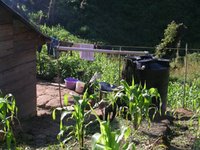 In June of last year I had the opportunity to experience the lifestyle of an indigenous Mayan family living in the Guatemalan highlands, in a remote community 2400 meters above sea level. My experience began with a 2 hour hike uphill through mud and rain to reach the family’s home. It nearly killed me, and I was more than a little humbled to learn that the father of the household (who had accompanied me) had to do the round trip six days a week.
In June of last year I had the opportunity to experience the lifestyle of an indigenous Mayan family living in the Guatemalan highlands, in a remote community 2400 meters above sea level. My experience began with a 2 hour hike uphill through mud and rain to reach the family’s home. It nearly killed me, and I was more than a little humbled to learn that the father of the household (who had accompanied me) had to do the round trip six days a week.
I was faced upon arrival with a totally alien landscape. It was a scene devoid of power lines, plumbing systems or cars, even the faint buzz of a radio was eerily absent. The home I was to stay at was one of a collection of timber or mudbrick huts clinging precariously to the mountainside.
My host family’s home was a dirt floored, two room affair. One room contained two beds for guests (it’s walls heartbreakingly decorated with carefully cut out newspaper clippings) and another of about the same size that acted as both kitchen and bedroom, furnished with some makeshift shelves, a wood fire and a single bed where the parents and their two little kids apparently slept all together. Rain water collected in a tank was used for washing clothes and bodies (this is done outside in the mud directly from the tank itself)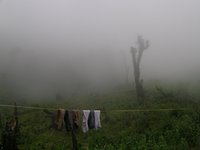 The families in this community eke out an existence by tending corn crops on land that they do not own themselves. They are very isolated from medical treatment and schools as the only access is via the dirt track I arrived on. Although the surrounding forest is stunning, it is gradually disappearing to provide firewood for the local community and more farming land, and during the wet season torrential rains further erode the cleared ground making it more and more unstable. Houses are not particularly structurally sound as they are built by people without the luxury of choosing sturdy materials or a secure location.
The families in this community eke out an existence by tending corn crops on land that they do not own themselves. They are very isolated from medical treatment and schools as the only access is via the dirt track I arrived on. Although the surrounding forest is stunning, it is gradually disappearing to provide firewood for the local community and more farming land, and during the wet season torrential rains further erode the cleared ground making it more and more unstable. Houses are not particularly structurally sound as they are built by people without the luxury of choosing sturdy materials or a secure location.
For most of us I’d say it’s pretty hard to visualize living in a place like this, but I’m going to ask you to stretch your imagination a bit further and imagine what happens when such a place is hit by a hurricane. In fact Hurricane Stan didn’t hit Guatemala directly but in just passing close by managed to cause massive mudslides and flooding. The area I visited escaped the worst of it, but in some parts entire villages just disappeared, huge chunks were torn out of bridges and roads and people were buried alive. According to the final figures something like 670 people were confirmed dead (although many more bodies were never recovered) over 25,000 homes were damaged and over 9000 completely destroyed. Numbers like this are always released following a natural disaster (and consistently refined and re-released) and they go some way to quantifying the extent of the damage, but in a way they’re meaningless and they’re difficult to move beyond.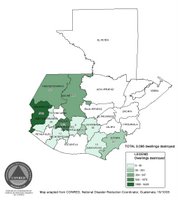 Yes, they can give the international community some idea of the amount of financial aid required, but they tend to paralyze us as individuals – they make the situation out to be so big that we feel powerless and they don’t personalize the events at all. My point is that designers aren’t conditioned to respond mechanically to a sudden need for 9000 new houses – we work with a unique client, site, budget and set of needs to come up with a specific, personal solution.
Yes, they can give the international community some idea of the amount of financial aid required, but they tend to paralyze us as individuals – they make the situation out to be so big that we feel powerless and they don’t personalize the events at all. My point is that designers aren’t conditioned to respond mechanically to a sudden need for 9000 new houses – we work with a unique client, site, budget and set of needs to come up with a specific, personal solution.
So what role could an architect possibly have in the rebuilding process?
5 months down the track, Guatemala now faces the challenge of salvaging a country that was already in pretty bad shape. I would argue that it is now and in the coming months that most international help is needed, although the immediate horrors of ruined possessions and grief stricken mothers have long disappeared from our TV screens. Even if living standards are restored to their former level, the country is at risk of becoming entrenched in a cycle of devastation, rebuilding and further devastation. But given that getting back to that same level is itself a mammoth task for people who are now totally destitute, how is it possible to go above and beyond? Well, from a practical viewpoint: inappropriate siting of buildings, unsafe construction, as well as nowhere secure to go in the case of evacuation, aggravated the damage caused by the hurricane. There is a chance to rectify these mistakes in the reconstruction, and an architect’s involvement to advise on these basic things could be worthwhile.
Well, from a practical viewpoint: inappropriate siting of buildings, unsafe construction, as well as nowhere secure to go in the case of evacuation, aggravated the damage caused by the hurricane. There is a chance to rectify these mistakes in the reconstruction, and an architect’s involvement to advise on these basic things could be worthwhile.
But I think the real answer may lie in rethinking the concept of rebuilding outside of merely practical terms.
It’s not just about four walls and a roof. By this I don’t mean that it’s an appropriate time to experiment with outlandish designs and spatial poetics, but that the social fabric of whole communities is also in need of repair. Many of those affected previously survived on farming or weaving textiles to sell to tourists. Wiped out crops and buried equipment means people have lost their livelihoods. Cultural identity is also endangered. In one of the worst hit areas, Panabaj, some members of the Mayan community are wearing donated Western clothes for the first time ever. This might not seem particularly striking, until one considers that Mayan communities continue to dress in handmade garments specific to each region, and now their inability to afford new looms and materials to weave their traditional dress represents a significant cultural blow. Further to this, families have been torn apart, many children were orphaned and kids as young as 6 years old are now looking after their little brothers and sisters.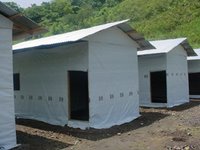 So we’re really talking about piecing together individual and also collective identities, and while these may be intangibles in themselves, architects are generally well placed to draw out and interpret intangible issues. A sense of community has an importance in Latin America that our very much me-focused Western society can’t fathom, and in villages that can afford it the central focus of the community is physically the town centre, usually consisting of a church and plaza where people can gather. I see the reconstruction or establishment of communal nodes, like schools, town halls, clinics and maybe foster homes as being crucial to a process of renewal, as well as potentially being secure buildings suitable as evacuation points in the event of a future disaster. And once we get down to the scale of an individual community confronted with these needs, what should emerge but a unique client, site, budget and set of needs requiring a specific, personal solution.
So we’re really talking about piecing together individual and also collective identities, and while these may be intangibles in themselves, architects are generally well placed to draw out and interpret intangible issues. A sense of community has an importance in Latin America that our very much me-focused Western society can’t fathom, and in villages that can afford it the central focus of the community is physically the town centre, usually consisting of a church and plaza where people can gather. I see the reconstruction or establishment of communal nodes, like schools, town halls, clinics and maybe foster homes as being crucial to a process of renewal, as well as potentially being secure buildings suitable as evacuation points in the event of a future disaster. And once we get down to the scale of an individual community confronted with these needs, what should emerge but a unique client, site, budget and set of needs requiring a specific, personal solution.
What sort of skills are needed in the reconstruction stages? Well, some sort of construction knowledge as I said before. Communication skills, visual and verbal as English speaking is not always possible. Empathy. An appreciation of intangibles like cultural identity and personal feelings. Problem solving skills. Ability to work within constraints. Willingness to listen and learn from local knowledge and needs as much as the contribution of new ideas. Also a bit of a sacrifice of ego wouldn’t hurt. Do I really need to draw the obvious conclusion here? Aren’t these the things that we are trained to do as designers? The ego thing might be a bit of a challenge, but most of us are probably dealing with the others at school or at work in some shape or form every day.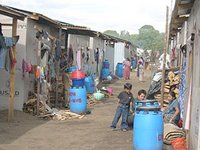 I don’t want to over-simplify the situation. Obviously, even if we as individuals make the decision to contribute time and skills, funding has to come from somewhere for a start. Also, the recovery process is beset with much bigger problems that can only be addressed by the Guatemalan government. But to be overwhelmed by the scale of the situation is to miss opportunities to make inroads from within – we risk missing the trees for the size of the forest. Just what is at stake here? It is not quite a re-imagining of our roles as architects, but perhaps a re-ordering of our skill set; recognizing the value of communication skills, lateral thinking over abstract design sensibilities. The common view of architects held by those outside the field is dramatically different to our own self-perception and it’s not hard to see why; an entire ideological discourse is going on behind the closed doors of academic circles and institutions that rarely translates into real projects. What is the rhetoric really worth if it doesn’t ever become action? Working in a devastated country is a chance to demonstrate that there is more to architects than black suits and over-fed vocabularies. More importantly it’s an opportunity to rediscover the importance of engaging with clients, and be involved in genuinely worthwhile projects. I am far from the first person to have expressed these views, and that is possibly the most encouraging sign. I see designers as having the potential to operate at two levels: one being at the coal face, working with already established aid organizations and local people, and the other as a collective group petitioning governments and decision-makers.
I don’t want to over-simplify the situation. Obviously, even if we as individuals make the decision to contribute time and skills, funding has to come from somewhere for a start. Also, the recovery process is beset with much bigger problems that can only be addressed by the Guatemalan government. But to be overwhelmed by the scale of the situation is to miss opportunities to make inroads from within – we risk missing the trees for the size of the forest. Just what is at stake here? It is not quite a re-imagining of our roles as architects, but perhaps a re-ordering of our skill set; recognizing the value of communication skills, lateral thinking over abstract design sensibilities. The common view of architects held by those outside the field is dramatically different to our own self-perception and it’s not hard to see why; an entire ideological discourse is going on behind the closed doors of academic circles and institutions that rarely translates into real projects. What is the rhetoric really worth if it doesn’t ever become action? Working in a devastated country is a chance to demonstrate that there is more to architects than black suits and over-fed vocabularies. More importantly it’s an opportunity to rediscover the importance of engaging with clients, and be involved in genuinely worthwhile projects. I am far from the first person to have expressed these views, and that is possibly the most encouraging sign. I see designers as having the potential to operate at two levels: one being at the coal face, working with already established aid organizations and local people, and the other as a collective group petitioning governments and decision-makers.
It’s time for architects to swallow the fear of being too political; the built environment is already political, it always has been. I believe that having the world at our fingertips should entail some sort of shared responsibility, not just for the faceless concept of the ‘global community’, but the real people who live there.
Photographs (from top to bottom):
(click on photo to see a larger image)
- Mayan_family_kitchen - Dinner is served in the kitchen (also a bedroom)
- A single rainwater tank is the household's only source of water
- A blanket of cloud descends on the mountain mid-afternoon
- Map - Extent of housing damage in Guatemala (excluding buried villages)
- Stan in huehue - City of Huehuetenango post-Hurricane Stan
- Shelter - Plastic sheeting clad shelters proposed for emergency housing
- Tent city pan - Shelter villages in February, four months after hurricane






1 comment:
"we work with a unique client, site, budget and set of needs to come up with a specific, personal solution.
So what role could an architect possibly have in the rebuilding process?"
This is very important Eleanor, and it points to education. We architects (with some exceptions), have not received and education that enable us to be socially minded. We are educated to serve individuals, not the community. Fortunately, this is not the case everywhere else where urbanism, (studied simultaneously), allow students to engage not only with surrounding infrastructure but the larger social space.
Beatriz
Post a Comment
Please select a profile under "comment as". If you don't have a profile, sign as "anonymous" making sure you write your name in the body of your comment.